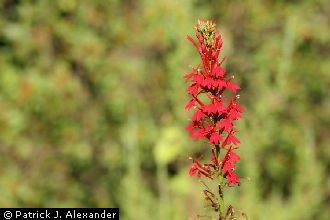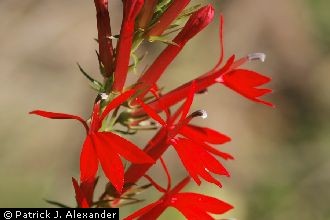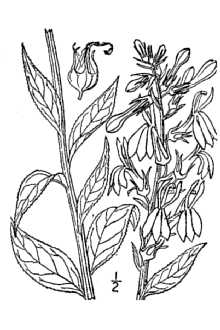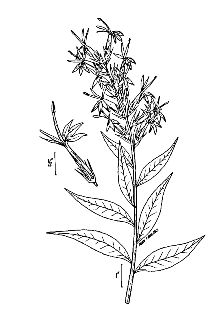Cardinalflower
Scientific Name: Lobelia cardinalis L.
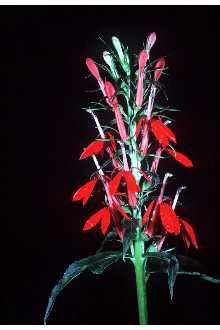
| General Information | |
|---|---|
| Usda Symbol | LOCA2 |
| Group | Dicot |
| Life Cycle | Perennial |
| Growth Habits | Forb/herb |
| Native Locations | LOCA2 |
Plant Guide
Alternative Name
Indian pink
Uses
Ethnobotanic: The Iroquois had many medicinal uses for cardinal flower, Use soil moisture sensors to measure the soil moisture of Cardinalflower., The root was boiled together with the root of Cichorium intybus and the liquid was used to treat fever sores, The mashed roots, stems, leaves, and blossoms were made into a decoction and drank for cramps, The plant was also used as an emetic for an upset stomach from eating something bad, The plant was added to other medicines to give them more strength, The Delaware used an infusion of the roots to treat typhoid, The Meskwaki used this plant as a ceremonial tobacco, throwing it to the winds to ward off a storm, The Pawnee used the roots and flowers of cardinal flower in the composition of a love charm, Wildlife: Hummingbirds are attracted to the nectar, Deer browsing often damages young plants,
Status
Please consult the PLANTS Web site and your State Department of Natural Resources for this plant’s current status, such as, state noxious status and wetland indicator values. © William S. Justice Smithsonian Institution, Department of Botany @PLANTS
Description
General: Bellflower Family (Campanulaceae). This herbaceous perennial is 5 to 15 cm. tall with unbranched stems. The alternate leaves are toothed and oblong to lance-shaped and pointed at both ends. The irregular, two-lipped flowers are tubular with the upper portion two-lobed and the lower spreading and divided into three parts. The fire engine red flowers appear in long terminal racemes and they are from 30-45 mm. The anthers are at the end of a slender red filament tube extending out over the lower lip of the corolla. The corolla has a slit on each side near the base. The seeds come in a two-celled, many-seeded capsules opening at the top. They are small, less than 1 mm. and numerous.
Distribution
This plant is found in wet soil from New Brunswick to Minnesota, south to the Gulf of Mexico. For current distribution, please consult the Plant Profile page for this species on the PLANTS Web site.
Establishment
Adaptation: Cardinal flower is comparatively easy to grow. The capsules can be collected in autumn, usually October. The stalks are cut below the capsules, and placed upside down in a per sack. Once, home, the bag is opened so that the capsules are exposed to the air for a few days. Shake the bag to release the seeds. Crushing the capsules with a rolling pin and picking out the seeds from the litter can retrieve the capsules that have remaining seeds. The seeds can then be planted right away. Propagation by seeds: The seeds will germinate without cold stratification, but they need light, so sow the seeds in a flat with a damp fine grade peat light mix. Keep the flats moist and under lights or in a greenhouse. They should green up in a few weeks. Transplant them in 4-6 weeks into individual pots such as 70 cell plug trays, use the same potting mix and keep fertilizing. The seedlings are tiny at first, so fertilize them every other week with a liquid fertilizer. After another 4 weeks they can be put out in the garden or transplanted into larger pots of 4 to 6 inch diameter. Plant the plants in an outdoor spot that is in full sun or very light shade and never dries completely. Space the plants 8 to 12 inches apart. Add plenty of peat moss when planting and mulch well to keep the soil cool and moist. Protect the plants from deer. Cardinal flower will take two years to bloom, forming a large rosette the first year. Allow the plants to self-sow. They are heavy feeders, so compost or a shot of granular fertilizer when they begin growth is recommended. Propagation by cuttings: Take two node stem cuttings (4-6 inches) before the flowers open and remove the lower leaf and half the upper leaf. Treat the cutting with hormodin 2 or roottone and place the cuttings in a sand and perlite medium, cover lightly, water, and remember to keep the medium moist. Roots will form in 2-3 weeks, but the cuttings need to force a good new crown from the lower node to successfully over-winter.
Management
When well established, clumps of this plant can be divided in the fall or spring by separating the rosettes or basal offshoots from the mother plant and replanting these divisions and watering them immediately. In the winter, keep the leafy offshoots at the base of the drying stems of old plants free of leaf litter to allow them full exposure to the air and sunshine. Cultivars, Improved and Selected Materials (and area of origin) Contact your local Natural Resources
Conservation
Service (formerly Soil Conservation Service) office for more information. Look in the phone book under ”United States Government.” The Natural Resources Conservation Service will be listed under the subheading “Department of Agriculture.” Seeds and plants of selected Lobelia cardinalis cultivars are available from many nurseries. It is best to plant species from your local area, adapted to the specific site conditions where the plants are to be grown.
Plant Traits
Growth Requirements
| Moisture Use | Low |
|---|---|
| Adapted to Coarse Textured Soils | No |
| Adapted to Fine Textured Soils | No |
| Adapted to Medium Textured Soils | Yes |
| Anaerobic Tolerance | Low |
| CaCO3 Tolerance | Medium |
| Cold Stratification Required | No |
| Drought Tolerance | Medium |
| Fertility Requirement | Medium |
| Fire Tolerance | Low |
| Frost Free Days, Minimum | 130 |
| Hedge Tolerance | None |
| pH, Maximum | 7.8 |
| pH, Minimum | 5.8 |
| Planting Density per Acre, Maxim | 10912 |
| Planting Density per Acre, Minim | 2728 |
| Precipitation, Maximum | 60 |
| Precipitation, Minimum | 28 |
| Root Depth, Minimum (inches) | 12 |
| Salinity Tolerance | None |
| Shade Tolerance | Tolerant |
| Temperature, Minimum (°F) | -34 |
Morphology/Physiology
| Bloat | None |
|---|---|
| Shape and Orientation | Erect |
| Toxicity | None |
| Active Growth Period | Spring |
| C:N Ratio | Medium |
| Coppice Potential | No |
| Fall Conspicuous | No |
| Fire Resistant | No |
| Flower Color | Red |
| Flower Conspicuous | Yes |
| Foliage Color | Green |
| Foliage Texture | Medium |
| Fruit/Seed Color | Blue |
| Growth Form | Single Stem |
| Growth Rate | Moderate |
| Height, Mature (feet) | 5.9 |
| Known Allelopath | No |
| Leaf Retention | No |
| Lifespan | Moderate |
| Low Growing Grass | No |
| Nitrogen Fixation | None |
| Resprout Ability | No |
| Fruit/Seed Conspicuous | No |
Reproduction
| Propagated by Seed | Yes |
|---|---|
| Propagated by Sod | No |
| Propagated by Sprigs | No |
| Propagated by Tubers | No |
| Fruit/Seed Persistence | No |
| Seed per Pound | 11292758 |
| Seed Spread Rate | Slow |
| Seedling Vigor | High |
| Small Grain | No |
| Vegetative Spread Rate | None |
| Propagated by Corm | No |
| Propagated by Container | Yes |
| Propagated by Bulb | No |
| Propagated by Bare Root | No |
| Fruit/Seed Period End | Fall |
| Fruit/Seed Period Begin | Summer |
| Fruit/Seed Abundance | Medium |
| Commercial Availability | Routinely Available |
| Bloom Period | Summer |
| Propagated by Cuttings | No |
Suitability/Use
| Veneer Product | No |
|---|---|
| Pulpwood Product | No |
| Post Product | No |
| Palatable Human | No |
| Palatable Graze Animal | Medium |
| Palatable Browse Animal | Medium |
| Nursery Stock Product | No |
| Naval Store Product | No |
| Lumber Product | No |
| Fodder Product | No |
| Christmas Tree Product | No |
| Berry/Nut/Seed Product | No |

